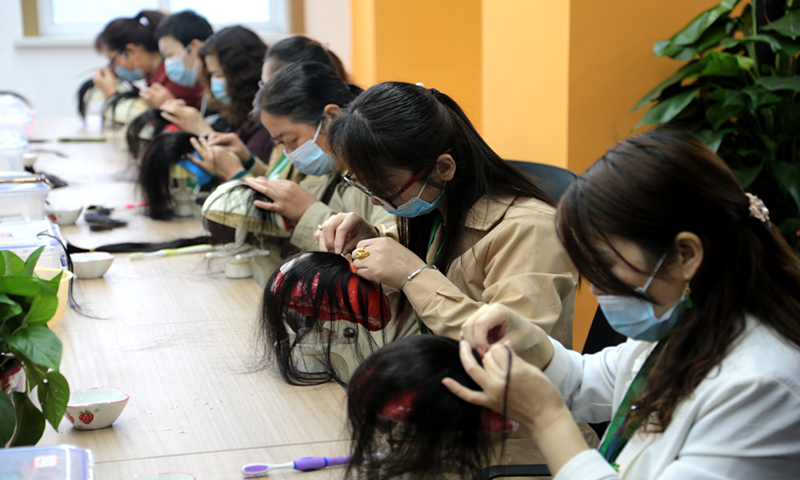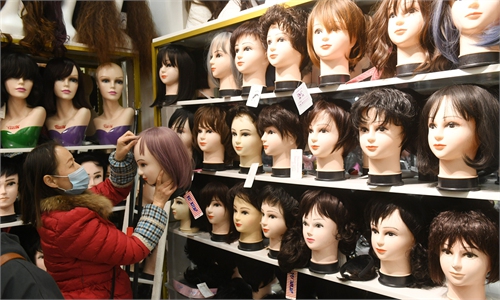
Workers produce wigs in a workshop in Northwest China's Shaanxi Province on May 16, 2021. Photo: VCG
Many Chinese wig producers are running short of raw material - genuine hair, which they used to import in large quantities from neighboring countries including India, but the surging coronavirus pandemic cut both production and transportation from those countries, industry insiders told the Global Times.
The situation is creating opportunities for companies with available hair inventory, particularly leading industry players.
"Now, who have real hair inventory have the whole market," Zhang Tianyou, deputy general manager of China's wig giant Rebecca, told the Global Times on Monday.
Out of raw materials
According to the industry practitioners, China has been heavily reliant on other Asian countries to import genuine hair as well as hair processing equipment. Currently, China imports most of its real hair from India, while countries like Thailand and Bangladesh also exported real hair to Chinese companies. Most of the hair is processed and knitted in North Korea.
However, the pandemic outbreak has caused many Asian countries to halt production or cut off transportation with China. North Korea, for example, has sealed off its borders to prevent the spread of the coronavirus for many months. This is causing wig companies in the country to run short of raw materials.
"As far as I know, many wig companies in China are close to running out of hair inventory, which is causing wig demand to significant outrun supply," Zheng Jiangmin, manager of the Dongyang Lansi Wig Co, a wig producer, told the Global Times on Monday.
Zhang Tianyou, deputy general manager of China's wig giant Rebecca, said that because many small factories in China don't stock raw materials, many have already halted production.
The lack of raw materials and the inconvenient shipping have caused the price of hair materials to surge in recent months. For example, the price of some real hair lace strips has surged by 10 times, Zheng said.
The raw material price surge has also pushed up the price of end products. Zhang disclosed that the company had raised the price of its products twice recently, and is considering another price rise soon.
"The price of real hair has surged almost three times, and we have no choice but to increase our product price to follow the market fluctuations," Zhang said.
To cope with the situation, many domestic companies have tried to train their own hair knitters. Rebecca, for example, has started to train domestic hair knitters at a time when hand-knitted hair was hard to source from overseas countries.
Zhang told the Global Times that he visited dozens of Chinese provinces during the epidemic last year trying to develop hand-knitting bases. The company also developed similar bases in five overseas countries to fill the industry gap after North Korea locked its borders.
However, this is not a problem to be solved easily, the industry sources said.
"It is not easy to train hair knitters in a short period of time, not to mention that China's labor cost is much higher than that in some other Asian countries," Zheng said. According to him, so far, China is still not able to have a real hair knitting industry with scale production.
"I would say that there's still no effective solutions to the dilemma at present," Zheng said.
Inventory windfall
Behind the domestic wig makers' desperate search for raw materials and processors are the country's burgeoning wig industry, including those made of human hair and chemical fiber. Now, there are thousands of wig factories in China, mostly located in East China's manufacturing hub Yiwu in Zhejiang, Henan's Xuchang which is dubbed "the world's wig capital", and Qingdao in East China's Shandong Province.
About 30 percent of the wigs are sold in China while the rest are exported, particularly to the US, European and African countries.
Overseas demand is the primary force behind China's wig industry. According to data provided by Chinese international e-commerce platform AliExpress, the platform's turnover for wigs doubled in April 2020, with African countries seeing the fastest growth in demands for Chinese wigs. Generally, one China-made wig is sold every two seconds on the platform.
This explains when the coronavirus pandemic shut the borders of many Asian countries, why it sent shockwaves through a long and very complicated industry chain in China, affecting numerous companies.
According to Zheng, the problem of rising cost is also for a challenge for fiber wigs, though not as serious as the challenges faced by the real hair industry.
"For companies like us, which mostly produce fiber wigs, the price of raw materials has surged by about 10 percent along with oil price fluctuation at the beginning of the year, while transportation cost has edged up by less than 30 percent," he said.
However, industry practitioners stressed that not everyone is suffering from strained market conditions, as companies that have ample real hair inventory, mostly large industry giants, are getting benefits.
Rebecca as China's largest wig producer, for example, said that the current real hair shortage has created "windfalls" for the company, as they have seen increasing orders when many smaller factories are unable to roll their machines.
Rebecca's Zhang said that the company has stocked thousands of tons of real hair in what he called as the firm's "strategic reserves." His company's orders have now been arranged till March 2022.
Rebecca's board secretary Hu Liping told the media earlier that whoever has real hair inventory has the initiative in the market competition.




